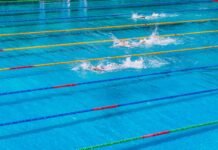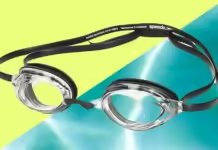Want to take your swim turns to the next level? Dryland exercises are a powerful way to help swimmers achieve quicker, more efficient turns and stronger push-offs.
Swim turns can make or break a race, as every second counts when approaching the wall, executing the turn, and powering off—no matter the stroke or distance.
While mastering proper technique and maintaining an aggressive approach to the wall are crucial, incorporating dryland training can greatly enhance the power, speed, and efficiency of your turns.
These exercises are designed to minimize wall contact time, boost your push-off power, and optimize your body position during turns and the push-off phase.
Ready to sharpen your turns? Let’s get started!
Dryland Exercises for Faster Swim Turns
To help achieve the goal of fast, crisp turns, swimmers should focus on the following dryland exercises:
- Squats
- Squat jumps
- Depth jumps
- Swiss ball knee tucks
- Jumping rope
These dryland exercises are designed to help you improve maximum power, force, and stability.
Adding these exercises to your dryland workouts will help reduce wall contact time during the turn. Strengthen stability and streamline off the wall. And build more short-twitch muscle fiber to help you to swim through the turns quickly.
Let’s take a look at each dryland exercise for faster turns in more depth.
1. Barbell Squats
Why: Improve lower body peak force.
The squat is a compound strength training exercise that simultaneously targets multiple muscle groups and joints. A squat is also exactly what you do when planting your feet on the wall (or bulkhead), pushing off, and wanting to generate peak force.
Studies with swimmers (Blanksby et al., 1996) have shown that turning time decreases when they can generate increased force on the wall.

This makes intuitive sense—the harder you can push off the wall, the faster you launch into a tight, crisp streamline, and the less time it takes to cover a length of the pool.
Personal best time, unlocked.
The squat is the best lower body exercise for developing a more forceful push-off, no matter what kind of swim turn you do.
A study published in the Journal of Human Kinetics showed that performing squats before a time trial swim significantly increased push-off velocity and reduced time to the 5m mark.
Here are some tips for how to do squats properly:
- Load the barbell and position the feet shoulder-width or slightly wider.
- Angle the toes outward at ~10 degrees.
- Keeping the back neutral, descend slowly with the weight.
- Initiate the movement with the hips, tracking them backward like sitting in a chair.
- Keep the knees pointing in the same line as your toes. This helps protect the knees from caving in or the knees from splashing out sideways and placing the groin at risk.
- Reach proper depth, pause, and drive through the heels to return to the starting position.
To improve swim turn performance, program squats for high intensity and low repetitions. This means near 1RM weight and 3-5 repetitions per set.
For swimmers who don’t have access to a squat rack, there are some bodyweight squat variations swimmers can use for improved swim turn performance.
My two favorites include:
Paced Squats –Bodyweight pace squats are an excellent alternative for beginner swimmers and those who don’t have ready access to a rack and free weights. Perform a squat, but do it slowly: 3s down, hold for 1s, 3s back up. Paced squats teach control, body awareness and the increased time under tension is awesome for muscle activation and hypertrophy (Burd et al., 2012).
Streamline Squats – Streamline squats are part assessment tool and part bodyweight exercise. The exercise is performed exactly as described: Place your hands in an overhead streamlined position and try to perform a bodyweight squat. Swimmers with poor hip or ankle mobility will find the upper body tilts forward as they squat. Streamline squats are a tool to quickly assess if swimmers have sufficient mobility to exert maximum force and power when doing swim turns.
2. Squat jumps
Why: Increase lower body power to push off faster.
Squat jumps are a lower-body plyometric exercise that involves a fast and forceful extension of the hips, knees, and ankles.
Where the traditional squat is all about control and force, squat jumps turn that force into power. (Power is the ability to produce force in an explosive nature.)
The squat jump is an excellent dryland exercise for swimmers as it is essentially an Olympic lift without the equipment. Squat jumps improve body awareness and is an awesome activation exercise before high-intensity swims (like a sprint swim race, for example).

Swimmers need to exert a ton of power to get off the wall quickly, and the squat jump is the perfect dryland exercise for building maximum power.
A paper with collegiate athletes performing squat jumps showed that maximum power was generated using just bodyweight compared to 20, 40, 60, and 80% 1RM loads, so don’t worry about adding load with this exercise.
Here’s how to do squat jumps like a pro:
- Place your feet in a shoulder-width position, with toes very slightly pointed outward.
- Brace the core and extend the hips backward as though sitting in a chair.
- Once you hit depth (don’t go past 90-degrees), fire the quads, hamstrings, and glutes to go vertical.
- Land softly, take a moment to collect yourself, and repeat for 3-5 repetitions, for 5-8 sets.
The goal with squat jumps is not pure exhaustion; it’s delivering maximum power with each repetition.
Squat jumps are also an excellent introduction to the other plyometric exercise for swim turns in this guide, which we will turn to now.
3. Depth jumps
Why: Reduce wall contact time during swim turns.
Depth jumps are a plyometric exercise that involves dropping from a raised surface and immediately launching into a vertical jump.
This dryland exercise is perfect for improving swim turn performance as it builds explosive power, improves reaction time, and teaches you to quickly apply power and reduce contact time with the ground.
Just like how you want to reduce wall contact time and generate maximum power when pushing off when doing a swim turn.
Wall contact time (WCT) is a key component of fast swim turns, defined as the gap between the moment you first touch the wall and when your last toe has left the wall.
Unsurprisingly, studies of competitive swimmers have shown a shorter WCT to be linked with faster turn times (Pereira et al., 2006; Araujo et al., 2010).
The quicker you can plant your feet, exert full power, and launch yourself off the wall, the faster the time you will see on the clock.
Here are some tips for how to do depth jumps properly:
- Use an elevated box or platform of appropriate height. Start at a lower height to learn the movement before progressing to higher heights.
- Step off the platform’s edge so both feet hit the ground simultaneously.
- Bend the knees to absorb impact, and launch yourself into the air by performing a squat jump.
Below is a great video demonstration of how to perform depth jumps:
This is a maximum power exercise, meaning that it shouldn’t be performed quickly or rushed.
Take a few moments to collect yourself between repetitions to ensure maximum power each time you step off the elevated surface.
4. Swiss ball knee tucks
Why: Improve body control and streamlining.
A Swiss ball knee tuck is a plank variation that is highly specific to the movement swimmers make when turning.
When swimmers approach or touch the wall, there is a knee-tuck component to the turning motion, whether you are doing a flip turn, a two-handed touch turn, or an open turn.
Swiss ball knee tucks develop core stability and control so that you can turn in the water at speed and position the body most efficiently.

For this core exercise for swimmers, you will need a Swiss ball and enough space to get into a plank position.
In a study published in the Journal of Strength Conditioning and Research, Swiss balls, also known as stability balls or physioballs, significantly increased trunk balance and core muscle engagement compared to standard floor-based core exercises.
Here’s how to do the Swiss ball knee tuck:
- Get into a plank position, hands shoulder-width, placing the front of the feet on the Swiss ball.
- With a braced core, apply pressure to the Swiss ball with your feet and slowly pull the ball forward until your knees are tucked under your abdomen.
- Hold for a moment, and then extend the ball away from you to the starting position.
Start by doing 8-10 repetitions for three sets.
Focus on controlled movements and maintaining tension, as they are more potent than herky-jerky, unstable motions that don’t engage your core effectively.
5. Jumping rope
Why: General fast-twitch development and stronger ankles.
Jumping rope is an essential and no-frills dryland exercise for swimmers that strengthens the ankles, improves aerobic conditioning, and builds better motor control.
And yes, it will also help you improve your swim turns by promoting short-twitch muscle fiber growth and teaching you to be light on your feet.
A study organized by the National Strength and Conditioning Association with collegiate athletes found that a ten-week jump rope intervention produced explosive-reactive power improvements similar to and sometimes superior to a standard plyometric program.

In terms of improving swim turn performance, jumping rope also helps you “float like a butterfly and sting like a bee” by keeping you light on your feet.
A fast turn, with reduced dwell time on the wall and an explosive push-off, means having the ankle strength and short-twitch fibers to perform the movement crisply. Jumping rope develops these traits without fancy gym equipment or a steep learning curve.
(You will nick yourself a few times with the rope as you develop jump rope proficiency, however.)
Jumping rope is beginner-friendly, requires just $10 for a rope, and can be a game-changing addition to your dryland activation routine and swim turns.
Start by adding five minutes of 30 seconds of jump rope, alternating with 30 seconds of rest and progress up from there.
Can dryland improve swimming performance?
Yes, dryland can improve swimming performance. Dryland training has been shown to improve swim performance by 2 to 2.5% in intermediate and experienced competitive swimmers.
Studies with experienced swimmers show that a combined swimming and dryland regimen improves swim performance better than a swim-only approach to training.
Dryland workouts for swimmers are an excellent way to increase power, reduce the risk of injury, and improve your starts and turns in the water.
Wrapping It Up
Swimmers spend a lot of time in the pool honing their craft. While nothing will completely replace an efficient turn technique, implementing these dryland exercises can help you develop more power, force, and body control in your swim turns.
Fast turns require pushing off with force, reducing wall contact time, and maintaining a streamlined body position throughout. The dryland exercises above will help you do just that.
Add them to your regular dryland workouts, and take your swim turns and swim speed to new levels.
See more: The Best Swimming Goggles for Women



















